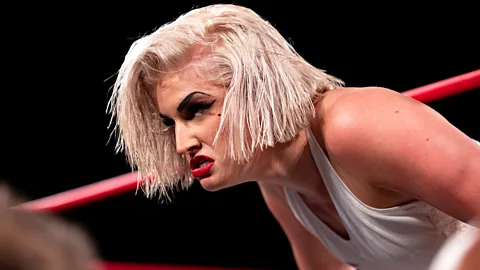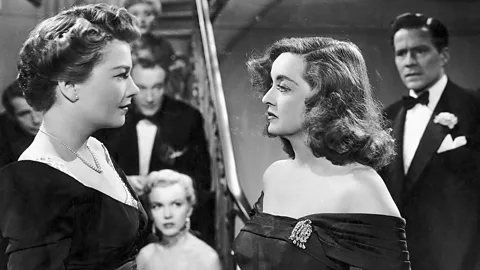All About Eve hits the ring: The wrestling feud inspired by Golden Age Hollywood
 AEW
AEWThe wrestling world is known for its creative costumes and storylines – and now two female rivals are modelling themselves on the Bette Davis/Anne Baxter classic.
A veteran performer, inspired by a young fan, takes the woman under her wing to nurture her as an understudy. But the route to the spotlight inspires cut-throat behaviour, and the protégé upstages her mentor so as to replace her entirely. For those familiar with cinematic history, this sounds like the plot of All About Eve – but in this case, it's actually the arc of a feud between two of the best women's wrestlers of the moment.
A quick rewind to this time last year: London played host to one of the biggest, if not the biggest, wrestling events in the country's history with All Elite Wrestling's All In, which filled out Wembley Stadium, a pretty remarkable achievement for a wrestling company that's only five years old. For those unfamiliar, All Elite Wrestling (AEW) owned by Tony Khan, is a relatively young entrant into the world of US professional wrestling. Matches are pre-determined, and rivalries between wrestlers are scripted using long-running fictional "storylines" over months or even years. The bouts are still legitimately physically fierce, however, and the end result is an artistic dance between narrative planning and live improvisation.
 AEW
AEWSince being founded in 2019, AEW has rocketed to prominence thanks to the strong alternative programming it's offered to the behemoth World Wrestling Entertainment (WWE), which was at a creative low point at the time (they've since bounced back). And now, in the wake of Taylor Swift performing at Wembley, the wrestling extravaganza of All In is set to return to the stadium on 25 August, with the aim of giving a large scale payoff for a number of overlapping, cascading storylines that are reaching a fever pitch.
The standout story this year, one which has played out across months of weekly television, and will now climax at All In with a title match for the Women's World Championship, is the conflict between the wrestlers "Timeless" Toni Storm and "The Glamour" Mariah May – and in their rivalry, they have been drawing from classic Hollywood, a unique accent to their narrative. Khan, who as well as being AEW owner is also responsible for the creative direction of many of the storylines, has directly cited Sunset Boulevard and All About Eve as inspiration, calling them "two of [his] favourites". Lyric Swinton, freelance wrestling writer/creative and host of the Maps & Graps Podcast, thinks this storyline may go down as "All Elite Wrestling's best work so far". "The investment in this story from both an administrative and fan perspective has been unprecedented for a women's feud in AEW, and every risk has paid off" she continues.
A lot of wrestlers use wider popular culture as a jumping-off point for their characters but usually such direct homages are contained to ring gear and walkout looks for big matches (one of my favourite examples: Kenny Omega walking out dressed as Sephiroth from Final Fantasy VII, accompanied by the character's theme). As a result, even through those little nods, the shows become a fun nexus point of the other interests of wrestlers and fans alike.
It's not standard, however, for wrestlers to make cracks about Turner Classic Movies or use the infamously salacious (and mostly made-up) Kenneth Anger book Hollywood Babylon as a sight gag.
 Getty Images
Getty Images"Wrestling takes from itself just as much as it does from its current cultural moment," says Katie Stebbins, a film zine creator and co-host of the Clean Finish podcast. "But harking back to the golden age of a different medium altogether feels like its own homage, acknowledging professional wrestling as its own constructed, heightened, and totally unique form of storytelling.
How the story has developed
The storyline, which has been playing out over the past year across AEW's thrice-weekly programming, really kicked off in the lead up to the 2023 All In, when Storm lost her title. This sent her into a spiral, her character gradually changing in a series of backstage interviews. Previously her styling leaned rockier, but now she was turning up talking like a washed-up, Golden Age Hollywood actress in the twilight of her career à la Sunset Boulevard's Norma Desmond (made funnier by the fact that she's only 28). The live interviews typically ended with her rambling loudly and throwing a shoe at her unsuspecting coworkers.
This developed further, as Toni's every on-camera appearance would be presented in black and white, complete with fake film grain. Now, her entrance music sounds like a classic film overture, she's billed as being "from Stage 7 of Warner Brothers Studios", her outfits have changed to silk gowns, and her in-ring gear looks like something Ingrid Bergman might wear to the beach. She got a butler. For a while she even quoted Sunset Boulevard directly, saying "Mr Khan, I'm ready for my close up!" and pausing for a quick camera zoom before defeating her opponents. And, despite being a millennial from New Zealand, Toni speaks of Jayne Mansfield and other Hollywood icons like she spent time in the trenches with them, all in the kind of transatlantic accent that actresses from the time might have.
Stebbins highlights how the "feud playfully remixes a general 'Old Hollywood glamour' with the specificity of two stone-cold classics", Sunset Boulevard and All About Eve, while also noting that these reference points aren't required reading for fans. "If you recognise them, it's great but if not, it doesn't impact the enjoyment at all". It may even encourage people to seek out the films for the first time.
Eventually, in November 2023, entered Mariah, the doe-eyed fan, who in backstage segments claimed that she came to AEW for Toni, and to follow in her footsteps – this is where the story got its All About Eve angle, with Toni starting to seem like Bette Davis's old-school star Margo being pursued by Anne Baxter's super-fan Eve. What followed was weeks of Toni shrugging Mariah off, as she fought for her attention. She finally won it by dressing up as Toni, walking to the ring with her idol's old theme music and wearing her old ring gear – and later, her own variations on it – and then, to complete the betrayal, vanquishing her.
 AEW
AEWTheir sparring even gained a romantic subtext, not least through another rivalry between Toni and Mariah's old tag teammate from the Japanese promotion Stardom, Mina Shirakawa. It was effectively a battle for Mariah's heart (Swinton also notes how the trio have invited comparisons to film of the moment, Challengers).
The storyline is a genuinely original meeting of cultural phenomena, which has won over a lot of wrestling fans, given Mariah May some absolutely star-making time in the spotlight (Stebbins calls her "fully worthy of being the 'Eve' to Toni's 'Margo/’Norma'"), and provided an incredible revitalisation for Storm's character. As Stebbins puts it, "in real time we experienced Toni go from a placeholder women's champ indifferently received by audiences to losing the belt and gradually re-emerging as 'Timeless' Toni Storm. In real time, we experienced Toni the performer come remarkably into her own within Toni the character. It's part of what makes pro wrestling so endlessly fascinating, that the role of character and performer is always a simultaneous parallel and fusion." The same is true of Mariah, her newness to AEW adding to this immersive blend of fiction and person.
Why the fusion works so well
When it comes to Toni Storm, the initial (and delightful) absurdity of a wrestler acting as if they're from the 1950s has developed layers, with Toni slowly but surely developing seemingly real vulnerability as her rivalry with Mariah has progressed. Stebbins posits that being able to see these incremental changes in personality has added to the fun: "so much in wrestling is about timing, and the effect that the passage of time has on both performer and audience, and Toni / Mariah have utilised both in a way that doesn't often happen. We're with these performers week in and week out, watching performers evolve (or not), develop (or not), get over things (or not)."
The narrative drama has also been helped by the fact that Toni and Mariah are so fundamentally skilled as physical performers: as Swinton notes, beyond "the clever video packages and heated [live] segments, these are still two of the best in-ring workers in any women's division worldwide". Indeed, the introduction of Mariah exemplifies how great wrestling storytelling can be built in large part through physicality – where outside of the ring she's a fawning and excitable sycophant, once she steps through the ropes she reveals her capability to be a vicious bully towards an opponent who doesn't quite know what they're in for.
 AEW
AEWAs the storyline has developed further, it has pulled in yet another Golden Age Hollywood reference. Following her (rather brutal) betrayal by Mariah, Toni returned angrier and more erratic , now seemingly nodding to another Bette Davis-starring film, Whatever Happened to Baby Jane?, as she channelled Davis's appearance as bitter former child star Jane Hudson, both through her gown and severe makeup.
Toni and Mariah's storyline is pretty unique, and it's unlikely to spark a "classic cinema" trend in wrestling: Stebbins sees it as having a "lightning-in-a-bottle quality". But it nevertheless underlines the appeal of professional wrestling more generally. It's a showcase of its varied potential, fusing a heap of narrative elements – shared with theatre, comic books, soap opera, and in this case, classic cinema – with combat and extraordinary feats of athleticism. And it's fun to see how the wrestling world draws on specific bits of pop culture in order to forge connections with audiences and create its own unique artform in the process.
All In London is at Wembley Stadium on 25 August
--
If you liked this story, sign up for The Essential List newsletter – a handpicked selection of features, videos and can't-miss news, delivered to your inbox twice a week.
